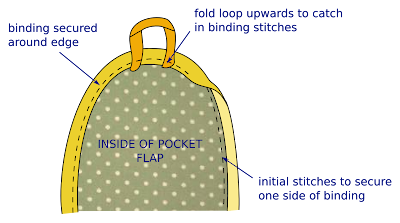Materials
Cut 4” x 6.3” pieces of the following:
- 2 x heavy sew-in interfacing
- 2 x stiff curtain buckram
- 1 x double-sided fusible
- 3 x felt (for the pages)
Cut larger 4.6” x 6.9” pieces of the following:
- 1 x front cover fabric
- 1 x lining fabric
You will also need:
- short piece of ribbon button for closure
- 10mm cotton tape for labels
- 1 sheet iron-on transfer paper
To make the page labels
Print out text or decoration with a maximum height of 9mm. I used inkscape to draw my designs and flipped them to a mirror image before printing them onto the iron-on transfer paper.
I used text to label the sort of machine label, and a measuring tape design to indicate the needle size. You can download my labels here: (pink or green).
Cut out the pieces and iron them on to the 10mm cotton tape (I pressed for 1 minute through a tea towel).
To make the cover
You will be making a 5-layer sandwich as shown here:
 |
| 5 layer sandwich to create a stiff book cover with a soft surface |
Iron the double-sided fusible to one of the buckram pieces. Peal off the paper, and position the glue-side onto the other buckram piece. Fuse the two buckram pieces together. While you do this, keep the interfacing on the opposite side to the fusible: I found enough glue leaked through the buckram to almost hold the interfacing on! Before the sandwich cools and hardens, make the spine fold and press in with the iron.
 |
| Folded cover sandwich |
Since the interfacing is only lightly attached, baste around the edges with a long stitch to hold everything together. Make sure the interfacing does not crease around the inside of the spine!
Arrange the cover fabric around the stiff buckram sandwich. Press the excess fabric toward the inside of the book and catch-stitch to the interfacing to hold it in place. Make sure you do this with the cover bent along the spine so that the fabric can be pulled tightly around the spine but with enough give to allow the book to be closed. Mitre the fabric at the corners.
 |
| Covering the outside of the book cover |
At this point, affix the button to the outside of the front cover. I used my machine to stitch the button firmly on through all the buckram layers.
Using the cover as a guide, press the edges of the lining fabric underneath (to the wrong side) to create a rectangle just smaller than the book cover.
Create a loop of ribbon and stitch it to the right side of the lining fabric, with the loop pointing toward the spine: make the securing stitches in the unfolded edge of the fabric, between the raw edge and the crease you just pressed in. When you turn the edge of the lining back underneath, the loop should be pointing outward and the stitches hidden.
 |
| Folding the lining to size and adding a ribbon loop |
Stitch the lining to the inside of the cover using small invisible stitches. Do this with the book slightly closed so that excess lining fabric does not ripple near the spine.
 |
| Lining the book cover |
To make the pages
Sandwich three felt pages together and machine baste down the centre.
Fold along the spine stitching and use pinking shears to cut all the pages as one so that they are smaller than the book cover.
Top-stitch the labels to each page.
Finally, sew the pages into the cover by sewing through all layers along the spine.
 |
| Making the book pages |
This tutorial is part of a series:









